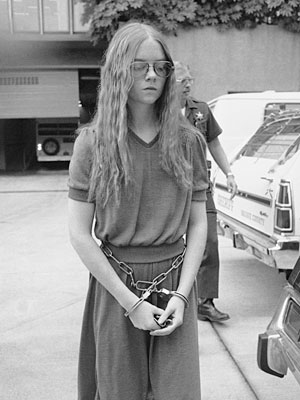“Ugh, it’s Monday” are the words that usually follow the arrival of the most dreaded day of the week. The sighs floating in the air are palpable and nothing seems possible. Mondays always carry with them a negative connotation and contain components such as depression, fatigue, and anguish. But to a San Diego elementary school, and to a troubled sixteen year old, Monday, January 29, 1979 held an even more distressing meaning.

Students at Grover Cleveland Elementary School, located in San Diego, California, began what they believed would be a normal Monday morning like any other, with bells ringing and students racing to their classes. Little did they know, however, that across the street, sixteen-year-old Brenda Ann Spencer was aiming her .22 caliber semiautomatic rifle right at society’s ultimate refuge, the elementary school, and its surroundings. After the first bell rang, Brenda broke the panels on the front door of her home, which was located right across the street from the elementary school. And she began to fire. The school’s principal, Burton Wragg, while rushing outside, was hit on the shoulder and chest with Spencer’s bullets and eventually died. Michael Suchar, the school’s custodian, ran outside with a blanket in order to cover Wragg and keep him from going into shock, but he quickly became the second victim of Spencer’s shooting and lost his life. In between all the chaos, 28 year old Robert Robb, a recent graduate of the police academy, while examining Wragg’s and Suchar’s bodies, was shot under his right shoulder blade.1 He would go on to survive though, along with the eight other children who were wounded in the incident. At least three of those children had abdominal wounds. A nine-year-old student, Cam Miller, was struck in the back with a bullet that exited through his chest without hitting any internal organs. Another, Christy Buell, was shot through her abdomen and in the buttocks, and had to undergo surgery in order to repair her intestine.2
When Gus Stevens, a reporter for the San Diego Evening Tribune, began calling around the area to gain more information about the shooting, he coincidentally placed a call to Spencer’s home where she gave him exactly what he wanted. She described the shooter, a sixteen year old, and the shooter’s address. When Stevens realized that she gave him her own address, he recognized what was going on and requested an interview while another staff member informed the police of the situation. The police, now aware of where the shots were coming from, were able evacuate the children and obstruct Spencer’s line of sight while trying to negotiate with her. After several hours, Brenda Spencer surrendered her weapon and several rounds of ammunition, and was subsequently arrested. While on the phone with Stevens, Spencer had stated that she was just shooting for the “fun of it.” She went on to say that she just didn’t like Mondays and did this “because it’s a way to cheer up the day.”3

Contrary to her initial claim, she later went on to state in her 2001 parole hearing that she had been “sexually abused by [her] father” and was “waiting for the cops to show up so they could shoot [her].”4 This new information has fueled many more theories today about Brenda Spencer’s true motives in committing such a crime. During her pretrial psychological testing, an injury to Spencer’s temporal lobe came to light. Spencer has also stated in a letter from prison that she experiences “grand mal seizures” that she has to counteract with medications.5 Such a brain injury would definitely be a precursor to epilepsy, which is two to four times more common among violent offenders than the public.6 The lack of treatment she received for this disease, to some, proves the neglect that she experienced from her family and in her childhood. Psychologist Jonathan Fast introduces the idea that her brain injury, abuse, and the effects of it pushed her to her final actions. He believes that the shame, ridicule, inferiority, and powerlessness that she felt encouraged her to go as far as she did. In another letter she wrote in prison, she stated that her “father had done everything a person could do to another person. The beatings, the touching, the emotional abuse.” She went on to state that no one, not teachers or counselors, gave her assistance through this, so she simply thought that this was how the world and how life worked. When her father gifted her the .22 caliber rifle, she thought that he was finally telling her to do it: to take her life successfully, unlike her past suicide attempts, and leave the world forever.7
Whether these theories are true or not, Brenda Spencer was tried as an adult and pleaded guilty to two counts of murder and nine counts of assault. She was sentenced to twenty-five years to life in prison, and is still serving her sentence at the California Institute for Women. The shooting has inspired a song by the Boomtown Rats called “I Don’t Like Mondays,” and has also gained other media coverage through a documentary.8 Her action went down in history as the first high profile school shooting and has become a vanguard to many future, unimaginable school situations and violent outbreaks. Whether Spencer was a cold-hearted killer or a truly lost and confused soul that simply wanted an escape, it is undeniable that her horrible actions have had some frightening consequences in our modern world.
- Jonathan Fast, Ceremonial Violence (New York: The Overlook Press, 2008), 25, 70-71. ↵
- Tamara Jones, “Look Back in Sorrow,” Good Housekeeping 227, no.5 (November 1998): 118. ↵
- Jonathan Fast, “Unforgiven and Alone: Brenda Spencer and Secret Shame,” in School Shootings: International Research, Case Studies, And Concepts For Prevention, ed. Nils Böckler (New York: Springer, 2013), 253-255. ↵
- Debra Sevey, “Subsequent Parole Consideration Hearing of Brenda Spencer,” (Capitol Electronic Reporting, 2001), 15-16. ↵
- Jennifer Furio, Letters From Prison: Voices Of Women Murderers (New York: Algora Pub., 2001), 134. ↵
- Jonathan Fast, ” Unforgiven and Alone: Brenda Spencer and Secret Shame,” in School Shootings: International Research, Case Studies, And Concepts For Prevention, ed. Nils Böckler (New York: Springer, 2013), 251. ↵
- Jennifer Furio, Letters From Prison: Voices Of Women Murderers (New York: Algora Pub., 2001), 134-135. ↵
- Encyclopedia of School Crime and Violence, September 2011, s.v. “Brenda Spencer,” by Laura L. Finley. ↵



243 comments
Christopher Sanchez
It breaks my heart to hear a school shooting happening at a elementary school. Mostly every school shooting is related to some form of mental illness. Brenda Spencer had a troubled childhood from her father messing with her physically and mentally. She was angry but doesn’t mean she has take it out on kids. If her father treated her differently maybe all this would never happened.
Johnanthony Hernandez
With the number of school shootings that have happened over the past decade, it’s interesting to see that a number of them have been related to some form of mental illness. I can only think of a few cases where the shooter was given the weapon by a parent, but I remember when I was studying for my associates we came to the subject of school shooting in one of my criminal justice classes. We discussed this case and if we felt that the sentence that she was given was an appropriate sentence for someone who may have been a confused kid or if this was something that she acted on without remorse.
Constancia Tijerina
Hating Mondays just turned into a more serious matter. I have heard of this case of young Brenda Spencer, but after reading this article it has opened my mind to the more emotional side instead of the facts of the case. Learning the type of neglect and abuse of Spencer has caused me to believe that this horrid tragedy has more to it than expected. Considering all the past neglect that Spencer had been through, it seems that rather than incarcerating her there should have been some treatment done to see if she is mentally fit to even stay in prison. Overall this article truly captures the unfortunate events that occurred that very day.
Carlos Vazquez
This article is very informative, I had no idea this happened before I read it. This incident is sad not only because of the kids and the other people at the school who got hurt, but for Brenda Spencer as well. She had to endure years of abuse and she clearly suffered from mental illness. Although what she did incredibly horrifying and unjustifiable, it’s just another example of the importance of mental health awareness and how we need to help before it’s too late and they hurt others simply because for the “fun of it.”
Arianna Kennet
I wasn’t expecting this story starting with how boring Mondays are to turn into an insane shooting by a girl younger than I am. That certainly escalated quickly! I am not sure how to feel about this story, and what to be more shocked at; the fact that the girl is only 16 years old, or the fact that she was pulling the trigger on the school for the fun of it. I would say her family definitely contributes to her wrong doings, because they chose to ignore the suffering she was going through and I don’t even want to get started on her father, he’s an animal. This somewhat serves as an eye opener on what kids go through and how they go unnoticed.
Monica Avila
Any shooting involving children is that much more heartbreaking. I immediately thought of the Sandy Hook Elementary shooting upon reading that it was an elementary school that Brenda Spencer targeted. No matter the reason, whether she was just bored or it was prompted by her brain injury, this shooting is not justified. Mental illness seems to more than always be the cause behind mass shootings, and as a political science major I can only call back to further restrictions on who is allowed to own and operate a gun.
Destiny Renteria
This article was more informational for myself because I have heard of this case before but I have finally understood a little bit more as to why Brenda Spencer may have took the actions she did that day. Although it was unfortunate for many students and teachers, this can be an outlook to the way mind works through emotional trauma and even physical. Not saying all abuse leads to this, but it can be a start to some studies as to the past of suspects who were involved in murders. It helped me understand the person Brenda was and how many of her experiences had a huge effect on her life.
Olga Perez
This article was completely shocking to me. I think what was most shocking to me was how Brenda had said she did it simply because she didn’t like Mondays. The different theories about Brenda and her motives are very interesting and i think both are very plausible. It kinda makes me sad to think that Brenda was possibly dealing with molestation or seizures and that’s the real reason why she did what she did.
Miranda Alamilla
Although Brenda Spencer claimed later that her actions were based off of psychological and physical abuse, her first statement was that she didn’t like Mondays and she started shooting to feel better. H er later comments about her dad sexually and physically abusing her, although I’m not denying their truth, are more of an after thought. Her poor family upbringing and surroundings could have played a role in shooting her gun with fatal outcomes, but I feel as though her motives were quite unclear and that her atrocious acts cannot be forgiven. She killed two people, Burton Wragg and Michael Suchar, who had families and lives; and injured nine children. I hope that she gets treatment for her temporal lobe and gets the counseling that she needs, but I also that she knows what she has done.
Clayton Trevino
It seems this incident might have led to some frightening consequences in modern day. Mass shootings, particularly when it comes to school shootings, are media field days because of just how scary the idea of being in that situation is to the American public. Despite school shooting only accounting for a small percentage of the amount of violent crime committed annually in the United States, people remain scared of becoming another victim of a mass shooting. This incident should serve to place more importance on preventing violent crime and treating the psychological ill rather than instilling fear to those who should feel safe.